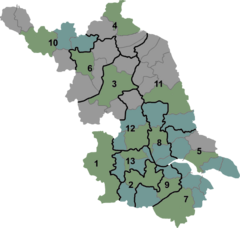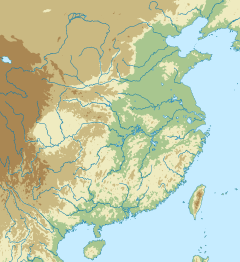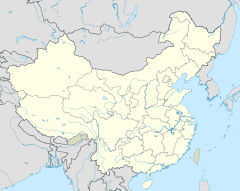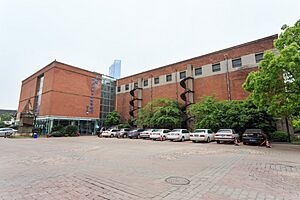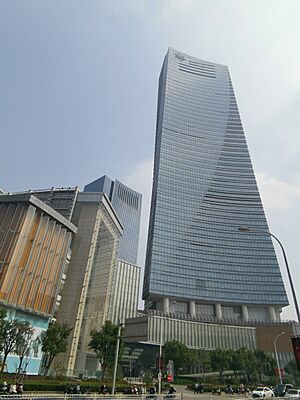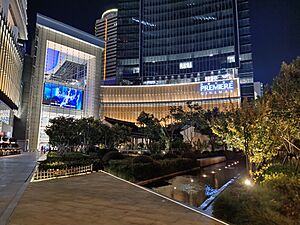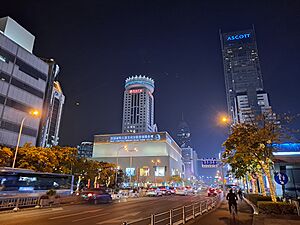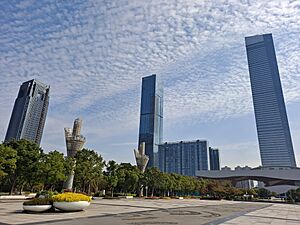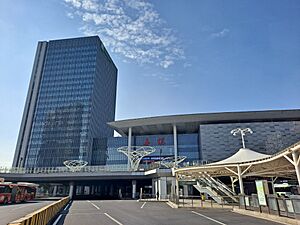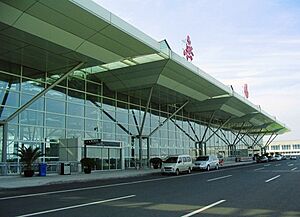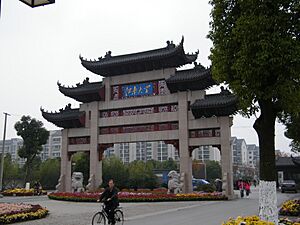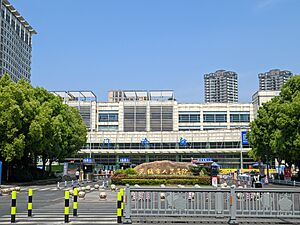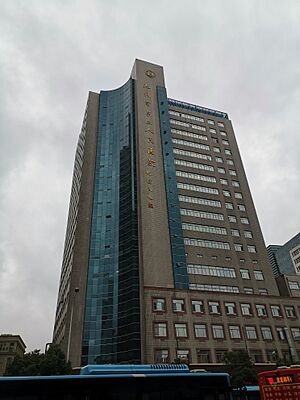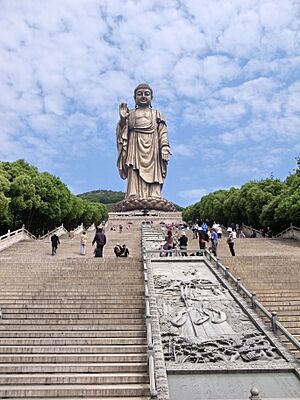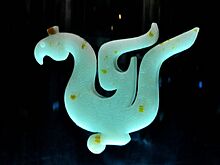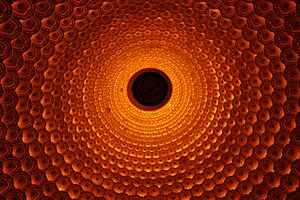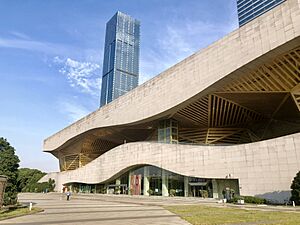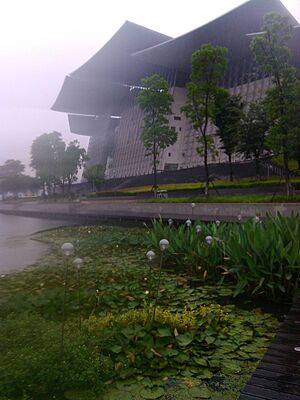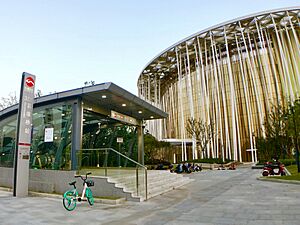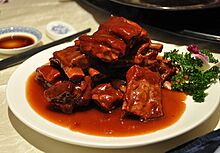Wuxi facts for kids
Quick facts for kids
Wuxi
无锡市
Wusih, Wuhsi
|
|
|---|---|
|
Prefecture-level city
|
|
|
SanYang Plaza
TaiLake New City
Tai Lake YuanTouZhu
Jichang Royal Garden
Qingming Bridge Cultural Block
Downtown Wuxi
|
|
| Motto(s):
Wuxi is full of warmth and water
|
|
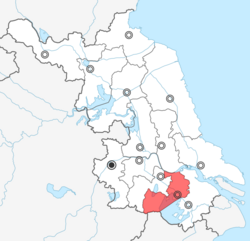
Location in Jiangsu
|
|
| Country | People's Republic of China |
| Province | Jiangsu |
| County-level divisions | 9 |
| Township-level divisions | 73 |
| Municipal seat | Binhu District |
| Area | |
| • Prefecture-level city | 4,628 km2 (1,787 sq mi) |
| Population
(2020 census)
|
|
| • Prefecture-level city | 7,462,135 |
| • Density | 1,612.39/km2 (4,176.1/sq mi) |
| • Urban | 4,396,835 |
| • Metro | 4,396,835 |
| GDP | |
| • Prefecture-level city | CN¥ 1.486 trillion US$ 209.5 billion |
| • Per capita | CN¥ 198,400 US$ 26,831 |
| Time zone | UTC+8 (China Standard) |
| Postal code |
Urban center: 214000
Other Area: 214200, 214400 |
| Area code(s) | 510 |
| ISO 3166 code | CN-JS-02 |
| License plate prefixes | 苏B |
| HDI | 0.902 - very high |
| Local Dialect | Wu: Wuxi dialect |
| Website | |
| Wuxi | |||||||||||||||||||||||||||||||||
|---|---|---|---|---|---|---|---|---|---|---|---|---|---|---|---|---|---|---|---|---|---|---|---|---|---|---|---|---|---|---|---|---|---|

"Wuxi" in Simplified (top) and Traditional (bottom) Chinese characters
|
|||||||||||||||||||||||||||||||||
| Simplified Chinese | 无锡 | ||||||||||||||||||||||||||||||||
| Traditional Chinese | 無錫 | ||||||||||||||||||||||||||||||||
| Hanyu Pinyin | PRC Standard Mandarin: Wúxī ROC Standard Mandarin: Wúxí |
||||||||||||||||||||||||||||||||
|
|||||||||||||||||||||||||||||||||
Wuxi (Chinese: 无锡, WOO-shee) is a large city in eastern China. It is located in the southern part of Jiangsu province. In 2020, over 7.4 million people lived there. Wuxi is found on the Yangtze River Delta and right by Lake Tai. It's often called the "Pearl of Taihu Lake" because of its beautiful scenery.
Wuxi is an important city in the Yangtze River Delta area. It is close to Shanghai and borders Zhejiang Province. This makes it a key transportation hub. The city is known for its long history and culture. It is considered the birthplace of Wu culture. Wuxi has been recognized as a major economic and tourist city in China.
Contents
The Name of Wuxi
The name "Wuxi" has an interesting story. The second Chinese character, 锡 (xī), means "tin". For a long time, people thought the city was named because tin mines in the area ran out.
However, many modern experts believe the name comes from an old local language. This language was spoken by people who lived in the area long ago. So, the name might not be about tin at all!
A Look at Wuxi's Past
Wuxi has a very long and rich history. It dates back to the Shang dynasty (1600–1046 BC). It was once the ancient capital of the Wu State during the Spring and Autumn period (770–476 BCE). The founders of the Wu State, Taibo and Zhongyong, settled here. They made Wuxi their first capital, which lasted for 600 years.
Wuxi became an official district in 202 BCE during the Han dynasty. It was named "Wuxi" at that time. Later, during the Yuan dynasty (1206–1368), it became an independent area. Wuxi and Changzhou are seen as the starting points for modern industry in China.
Growth and Trade
During the early Tang dynasty, farming and silk making grew strong in Wuxi. The opening of the Grand Canal in 609 made Wuxi a major trading spot. It became famous as one of China's biggest markets for rice.
The Donglin Academy was a special place in Wuxi. It was first built during the Song dynasty (960–1279). It was rebuilt in 1604 and became a public meeting place. People there discussed Confucianism and good behavior. Many of its members were retired government officials.
Challenges and Changes
In the 1800s, Wuxi faced a terrible event called the Taiping Rebellion. This conflict caused a huge loss of life. Nearly two-thirds of the population were killed.
During the Qing dynasty (1644–1912), cotton and silk production boomed. Trade increased when ports opened in Shanghai (1842) and Zhenjiang and Nanjing (1858). Wuxi became a key center for the textile industry in China. Factories for textiles and silk were built. Railways opened in 1908, further boosting trade.
After World War II, Wuxi's role as a top economic center changed. However, it remained an important manufacturing hub. Tourism also started to grow. In 1953, Wuxi became a provincial city when Jiangsu Province was formed. Today, it is a central city in the Shanghai and Suzhou-Wuxi-Changzhou metropolitan areas.
Wuxi's Weather
Wuxi has a humid subtropical climate. This means it has four distinct seasons. Summers are hot and humid, while winters are cool and damp. The city gets a good amount of rain throughout the year.
| Climate data for Wuxi (1991–2020 normals, extremes 1981–2010) | |||||||||||||
|---|---|---|---|---|---|---|---|---|---|---|---|---|---|
| Month | Jan | Feb | Mar | Apr | May | Jun | Jul | Aug | Sep | Oct | Nov | Dec | Year |
| Record high °C (°F) | 22.1 (71.8) |
26.8 (80.2) |
29.1 (84.4) |
34.8 (94.6) |
35.3 (95.5) |
38.1 (100.6) |
39.7 (103.5) |
40.1 (104.2) |
37.5 (99.5) |
33.1 (91.6) |
28.7 (83.7) |
22.5 (72.5) |
40.1 (104.2) |
| Mean daily maximum °C (°F) | 7.8 (46.0) |
10.2 (50.4) |
14.9 (58.8) |
21.0 (69.8) |
26.2 (79.2) |
28.9 (84.0) |
32.8 (91.0) |
32.3 (90.1) |
28.2 (82.8) |
23.1 (73.6) |
17.2 (63.0) |
10.6 (51.1) |
21.1 (70.0) |
| Daily mean °C (°F) | 3.9 (39.0) |
6.0 (42.8) |
10.2 (50.4) |
16.0 (60.8) |
21.4 (70.5) |
24.9 (76.8) |
28.9 (84.0) |
28.3 (82.9) |
24.2 (75.6) |
18.6 (65.5) |
12.6 (54.7) |
6.3 (43.3) |
16.8 (62.2) |
| Mean daily minimum °C (°F) | 0.9 (33.6) |
2.6 (36.7) |
6.4 (43.5) |
11.7 (53.1) |
17.2 (63.0) |
21.6 (70.9) |
25.7 (78.3) |
25.3 (77.5) |
20.9 (69.6) |
14.9 (58.8) |
8.9 (48.0) |
2.9 (37.2) |
13.3 (55.9) |
| Record low °C (°F) | −9.2 (15.4) |
−7.6 (18.3) |
−3.5 (25.7) |
0.7 (33.3) |
8.7 (47.7) |
11.6 (52.9) |
18.4 (65.1) |
18.3 (64.9) |
11.7 (53.1) |
2.8 (37.0) |
−3.2 (26.2) |
−8.0 (17.6) |
−9.2 (15.4) |
| Average precipitation mm (inches) | 66.3 (2.61) |
61.7 (2.43) |
83.6 (3.29) |
84.5 (3.33) |
95.4 (3.76) |
210.6 (8.29) |
180.8 (7.12) |
173.9 (6.85) |
92.1 (3.63) |
58.4 (2.30) |
59.3 (2.33) |
40.8 (1.61) |
1,207.4 (47.55) |
| Average precipitation days (≥ 0.1 mm) | 10.2 | 9.9 | 11.4 | 10.5 | 11.2 | 13.3 | 12.1 | 12.6 | 8.8 | 7.9 | 8.5 | 7.7 | 124.1 |
| Average snowy days | 3.0 | 2.0 | 0.8 | 0.1 | 0 | 0 | 0 | 0 | 0 | 0 | 0.2 | 0.9 | 7 |
| Average relative humidity (%) | 74 | 74 | 71 | 70 | 70 | 77 | 77 | 78 | 77 | 74 | 75 | 72 | 74 |
| Mean monthly sunshine hours | 123.0 | 124.0 | 145.8 | 171.0 | 181.4 | 136.7 | 189.5 | 185.4 | 161.9 | 162.4 | 140.3 | 139.0 | 1,860.4 |
| Percent possible sunshine | 38 | 40 | 39 | 44 | 43 | 32 | 44 | 46 | 44 | 47 | 45 | 45 | 42 |
| Source: China Meteorological Administration | |||||||||||||
City Layout and Districts
Wuxi is a prefecture-level city. It is divided into seven main areas. These include five districts and two county-level cities. The city's government is located in Binhu District.
These main areas are further divided into smaller parts. There are 73 township-level divisions. This includes 59 towns and 24 subdistricts.
| Map | |||||
|---|---|---|---|---|---|

Lake Tai
Ge
Lake Xishan
Huishan
Binhu
Liangxi
Xinwu
Jiangyin
(city) Yixing
(city) |
|||||
| Subdivision | Chinese | Hanyu Pinyin | Population (2020) | Area (km2) | Density (/km2) |
| City Proper | |||||
| Liangxi District | 梁溪区 | Liángxī Qū | 985,465 | 73.29 | 13,446 |
| Suburban | |||||
| Xishan District | 锡山区 | Xīshān Qū | 882,387 | 395.9 | 2,229 |
| Huishan District | 惠山区 | Huìshān Qū | 893,675 | 321.5 | 2,780 |
| Binhu District | 滨湖区 | Bīnhú Qū | 915,093 | 620.4 | 1,475 |
| Xinwu District | 新吴区 | Xīnwú Qū | 720,215 | 209.9 | 3,431 |
| Satellite cities (County-level cities) | |||||
| Jiangyin City | 江阴市 | Jiāngyīn Shì | 1,779,515 | 987.4 | 1,802 |
| Yixing City | 宜兴市 | Yíxīng Shì | 1,285,785 | 2,010 | 639.7 |
| Total | 7,462,135 | 4,618 | 1,616 | ||
| Defunct: Chong'an District, Nanchang District, & Beitang District | |||||
Wuxi's Economy
Wuxi has always had a strong economy. In 1895, the first Chinese-owned factory, Yeqin Cotton Mill, was started here. After that, many businesses grew quickly, especially in textiles, silk, and food processing. Wuxi became a key place for China's early industries.
Many famous business families, like the Rong and Tang families, came from Wuxi. After China opened up to the world, private businesses in Wuxi grew a lot. This was part of the "southern Jiangsu model" of development. Wuxi companies also became important on the stock market.
Wuxi is now a major economic center in eastern China. It is known as a very active business city. In 2013, it was named one of China's "new first-tier cities". This shows its strong overall economic power.
In 2022, Wuxi's economy reached new heights. Its total economic output was about 1.485 trillion yuan. This means the average person's income was very high, ranking second in China. The city is focusing on modern industries like the Internet of Things, integrated circuits, and biomedicine.
Business and Shopping
Wuxi is an important business hub in East China. Its location and history have helped its trade grow. The city has been a center for silk, tea, and rice since ancient times. Today, Wuxi's economy includes many service industries and high-tech businesses.
The city government works to make Wuxi a good place for businesses. This has brought many investors from China and other countries. Wuxi is now a regional business center with large industrial parks. These parks focus on new industries like electric motors and solar technology.
Wuxi's main shopping area is along Zhongshan Road in Liangxi District. You can find many large department stores and shopping malls there. Traditional markets like Chong'an Temple and Nanchan Temple are also popular.
Wuxi was one of the first cities in Jiangsu to have major foreign retail stores. This has made it a very important shopping destination. Many big international brands have stores here.
Getting Around Wuxi
Wuxi has a very good transportation system. This makes it easy to travel within the city and to other parts of China.
Trains and Metro
- Wuxi Railway Station is on the Shanghai–Nanjing Intercity High-Speed Railway. This railway connects Wuxi to major cities like Nanjing and Shanghai.
- Wuxi Metro is the city's subway system. It started running in 2014. As of early 2024, it has 5 lines and 97 stations. More lines are being built. The metro is very popular, with over 1.4 million passengers on record days.
Buses and Roads
- Wuxi has a large public bus system. It started in 1927. In 2020, there were 297 bus lines and over 3,000 buses.
- Major highways pass through Wuxi. China National Highway 312 connects it to central China. The Shanghai-Nanjing Expressway links Wuxi to Shanghai and other cities in Jiangsu.
Air and Water Travel
- Sunan Shuofang International Airport is located near the city center. It opened in 2004. You can fly directly to cities like Beijing, Shanghai, and even Singapore and Osaka.
- Jiangyin Port is a major port in Wuxi. It has many berths for ships. It handles a lot of cargo, including metal ore and coal. The port also has shipping routes to places like the Middle East and South Korea.
Learning and Research in Wuxi
Wuxi is a city that values education and research. It is known for its scientific discoveries.
Universities and Colleges
- Jiangnan University is a very important national university. It was first founded in 1902. It is a center for scientific research.
- Wuxi also has other universities like Wuxi University and the Wuxi Campus of Southeast University.
- There are many vocational and technical colleges. These schools help students get ready for jobs.
High Schools
Wuxi has many excellent high schools. Some of them have a long history:
- Tianyi Middle School in Jiangsu Province (founded 1946)
- Wuxi No. 1 Middle School (founded 1911)
- Wuxi Furen High School (founded 1918)
- Meicun High School in Jiangsu Province (founded 1913)
- Wuxi No. 3 High School (founded 1920)
- Wuxi Public Welfare Middle School (founded 1919)
Elementary Schools
The city also has historic elementary schools:
- Lianyuan Street Primary School in Wuxi City (founded 1898)
- Donglin Primary School in Wuxi City (founded 1902)
- Primary School Affiliated to Wuxi Normal School (founded 1913)
International Education
Wuxi offers international schools for students from different countries:
- Wuxi Nanwai Kings International School
- Wuxi International School
- Siying School for Children of Foreigners in Xinyu District
- Wuxi Foreign Language School
Healthcare in Wuxi
Wuxi has a long history of medicine. In ancient times, many famous doctors came from Wuxi. Some even worked for the royal family. There were also rare female doctors like Tan Yunxian.
Modern hospitals in Wuxi started in 1908. Today, Wuxi has a medical school and many hospitals. There are fourteen "tertiary hospitals," which are large, high-level hospitals.
- Wuxi No. 1 People's Hospital
- Wuxi No. 2 People's Hospital
- Jiangnan University Affiliated Hospital
- Wuxi Traditional Chinese Medicine Hospital
- Wuxi Children's Hospital
Sports in Wuxi
Wuxi is a city that loves sports. It has modern sports facilities.
- Wuxi Sports Center opened in 1994. It can hold 30,000 people. It has hosted big snooker events.
- Wuxi City Sports Park Stadium hosted the 2017 ITTF Asian-Championships (Ping Pong). It also hosted the 2019 World Cup in snooker.
- Major League Baseball has a special center in Wuxi. It helps find and train the best baseball players in China.
A new Wuxi Olympic Sports Center is being built. It will have a stadium for 60,000 people, a gym, and a swimming pool. This center will be able to host large national sports events.
Famous Places in Wuxi
Wuxi is a beautiful city with many places to visit. It is located on Lake Tai, which is China's third-largest freshwater lake. The lake has many islands and is great for boat trips.
Parks and Gardens
Wuxi has many lovely parks and gardens.
- Lihu Park was built in 1927. It has a long path with willow trees and small bridges.
- Changguangxi Wetland Park is a long canal connecting two lakes. It has a lotus pond.
- Wuxi Zoo and Taihu Lake Amusement Park is a big park with over 1,000 animals. You can see Asian elephants, leopards, and even giant pandas there.
- The Mt. Lingshan Grand Buddha Scenic Area is home to the Grand Buddha at Ling Shan. This is the world's largest bronze Buddha statue, standing 88 meters tall. The area also has other Buddhist sites like the Brahma Palace.
- Xihui Park has the beautiful Jichang Garden and the Dragon Light Pagoda.
Museums and Historical Sites
Wuxi has several museums and historical places to explore.
- Wuxi Museum is the city's largest public cultural building. It opened in 2008 and has many exhibitions. It also manages other museums like the Chinese National Industry and Commerce Museum.
- Hongshan Archaeological Museum shows artifacts from the ancient Wu culture. These items were found at the Hongshan Tomb Complex.
- The Helv City Ruins are very important. This was the capital of King Helu of Wu, built over 2,500 years ago. It is now a national archaeological site.
- The Former Residence of Xue Fucheng is open to the public. It was the home of a famous diplomat from the Qing dynasty.
- Wuxi also has the modern Wuxi Grand Theater and Sunac Taihu Show.
Famous People from Wuxi
Many talented people have come from Wuxi, including:
- Ni Zan, a famous painter (1301–1374)
- Xue Fucheng, a diplomat (1838–1894)
- Hua Yanjun, a musician (1893–1950)
- Liu Tianhua, a folk musician (1895–1932)
- Qian Zhongshu, a well-known writer (1910–1998)
- Marie Lu, a novelist (born 1984), author of the Legend series
Sister Cities
Wuxi has "sister city" relationships with many cities around the world. These partnerships help build friendships and cultural exchange.
Asia
 Akashi, Hyogo, Japan (1981)
Akashi, Hyogo, Japan (1981) Sagamihara City, Japan (1985)
Sagamihara City, Japan (1985) Gimhae, South Korea (2006)
Gimhae, South Korea (2006) Puerto Princesa City, Philippines (2007)
Puerto Princesa City, Philippines (2007) Sihanoukville, Cambodia (2009)
Sihanoukville, Cambodia (2009) Ulsan, South Korea (2014)
Ulsan, South Korea (2014) Tiberias, Israel (2015)
Tiberias, Israel (2015)
Europe
 Cascais, Portugal (1993)
Cascais, Portugal (1993) Vicenza, Italy (2006)
Vicenza, Italy (2006)  Leverkusen, Germany (2006)
Leverkusen, Germany (2006) Nimes, France (2007)
Nimes, France (2007) Sodertalje, Sweden (2007)
Sodertalje, Sweden (2007) Kortrijk, Belgium (2007)
Kortrijk, Belgium (2007) Beiserkellen, Denmark (2008)
Beiserkellen, Denmark (2008) Chelmsford, United Kingdom (2009)
Chelmsford, United Kingdom (2009) 's-Hertogenbosch, The Netherlands (2010)
's-Hertogenbosch, The Netherlands (2010) Lahti, Finland (2011)
Lahti, Finland (2011) Patras, Greece (2012)
Patras, Greece (2012) Zielona Góra, Poland (2014)
Zielona Góra, Poland (2014)
America
 Chattanooga, United States (1982)
Chattanooga, United States (1982) Fredericton, Canada (2010)
Fredericton, Canada (2010) Sorocaba, Brazil (2010)
Sorocaba, Brazil (2010) San Antonio, United States (2012)
San Antonio, United States (2012) Puebla, Mexico (2014)
Puebla, Mexico (2014)
Oceania
 Hamilton, New Zealand (1986)
Hamilton, New Zealand (1986) Frankston, Australia (2012)
Frankston, Australia (2012)
Africa
 Fez, Morocco (2010)
Fez, Morocco (2010)
|








